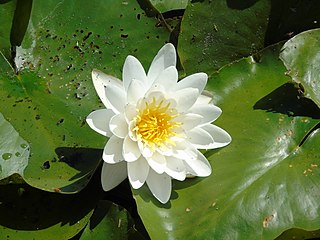
Nymphaea is a genus of hardy and tender aquatic plants in the family Nymphaeaceae. The genus has a cosmopolitan distribution. Many species are cultivated as ornamental plants, and many cultivars have been bred. Some taxa occur as introduced species where they are not native, and some are weeds. Plants of the genus are known commonly as water lilies, or waterlilies in the United Kingdom. The genus name is from the Greek νυμφαία, nymphaia and the Latin nymphaea, which mean "water lily" and were inspired by the nymphs of Greek and Latin mythology.

Triodia is a large genus of hummock grass endemic to Australia. The species of this genus are known by the common name spinifex, although they are not a part of the coastal genus Spinifex. Many soft-leaved Triodia species were formerly included in the genus Plectrachne. Triodia is known as tjanpi (grass) in central Australia, and have several traditional uses amongst the Aboriginal Australian peoples of the region.

Thomasia is a genus of thirty-one species of flowering plants in the family Malvaceae. Plants in this genus are small shrubs that are endemic to the south-west of Western Australia, apart from T. petalocalyx that is native to Victoria and South Australia. The leaves are simple with leaf-like stipules at the base of the petiole, the flowers bisexual with five papery, petal-like sepals, usually five petals and five stamens opposite the petals. The fruit is a capsule covered with star-like hairs.

Capparis is a genus of flowering plants in the family Capparaceae. It includes 142 species of shrubs or lianas which are collectively known as caper shrubs or caperbushes. Capparis species occur over a wide range of habitat in the subtropical and tropical regions of Africa, Eurasia, Australasia, and the Pacific.

Eucalyptus oleosa, commonly known as the red mallee, glossy-leaved red mallee, acorn mallee, oil mallee or giant mallee, is a tree or mallee that is native to Australia. The leaves were once harvested for the production of cineole based eucalyptus oil. Eucalyptus cneorifolia is now the predominant strain used in production due to a higher oil content in new growth.

Camphorosmeae is a species-rich tribe of the Amaranthaceae, formerly Chenopodiaceae, with 20 genera and about 179 species. It is classified as a single tribe of subfamily Camphorosmoideae.

Sclerolaena is a genus of flowering plants in the family Amaranthaceae. It includes 78 species of annuals or short-lived perennials native to Australia.
Hookerochloa is a genus of Australian plants in the grass family.
- Hookerochloa eriopoda(Vickery) S.W.L.Jacobs - Queensland, New South Wales, Victoria
- Hookerochloa hookeriana(F.Muell. ex Hook.f.) E.B.Alexeev - New South Wales, Victoria, Tasmania

Sclerolaena birchii, commonly known as galvanised burr, is a perennial shrub native to inland Australia.

Atriplex fissivalvis, commonly known as gibber saltbush, is a plant species in the family Amaranthaceae, subfamily, Chenopodioideae. It occurs in the Australian states of South Australia, New South Wales, Queensland and the Northern Territory.

Macarthuria is a genus of dicotyledonous plants belonging to the family Macarthuriaceae, and consists of about 9 species which are endemic to Australia.

Neobassia is a genus of small shrubs in the family Chenopodiaceae, which are included in Amaranthaceae family, according to the APG classification. Species are endemic to Australia.

Sclerolaena fimbriolata is a species of flowering plant in the family Amaranthaceae, native to central Western Australia. A small shrub, it is typically found growing on the edges of gypsum salt lakes.

Sclerolaena cornishiana, the cartwheel burr, is a species of flowering plant in the family Amaranthaceae, native to parts of northern Australia. An annual or perennial, it is an intricately branched herb with solitary flowers.

Sclerolaena anisacanthoides, the yellow burr, is a species of flowering plant in the family Amaranthaceae, native to eastern Australia. A perennial rounded subshrub reaching 15 cm (6 in), it is typically found growing in heavy soils.

Sclerolaena lanicuspis, the spinach-burr or copper-burr, is a species of flowering plant in the family Amaranthaceae, native to Australia. A woody perennial reaching 25 cm (10 in), it has tomentose branches and semiterete leaves.

Sclerolaena tricuspis, the giant redburr or three-spined Bassia, is a species of flowering plant in the family Amaranthaceae, native to eastern Australia. A shrub reaching 1 m (3 ft), it has slender terete leaves.

Sclerolaena eurotioides is a species of flowering plant in the family Amaranthaceae, native to Western Australia. It was first described in 1869 by Ferdinand von Mueller as Echinopsilon eurotioides, but was transferred to the genus, Sclerolaena in 1978 by Andrew John Scott.

Nymphaea immutabilis is a species of waterlily native to Western Australia, the Northern Territory, and Queensland, Australia.















